Related Research Articles
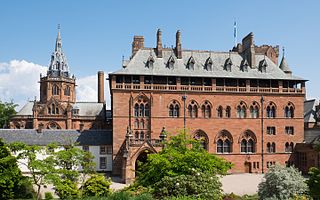
Mount Stuart House, on the east coast of the Isle of Bute, Scotland, is a country house built in the Gothic Revival style and the ancestral home of the Marquesses of Bute. It was designed by Sir Robert Rowand Anderson for the 3rd Marquess in the late 1870s, replacing an earlier house by Alexander McGill, which burnt down in 1877. The house is a Category A listed building.

Knightshayes Court is a Victorian country house near Tiverton, Devon, England, designed by William Burges for the Heathcoat-Amory family. Nikolaus Pevsner describes it as "an eloquent expression of High Victorian ideals in a country house of moderate size." The house is Grade I listed. The gardens are Grade II* listed in the National Register of Historic Parks and Gardens.

William Burges was an English architect and designer. Among the greatest of the Victorian art-architects, he sought in his work to escape from both nineteenth-century industrialisation and the Neoclassical architectural style and re-establish the architectural and social values of a utopian medieval England. Burges stands within the tradition of the Gothic Revival, his works echoing those of the Pre-Raphaelites and heralding those of the Arts and Crafts movement.

The Tower House, 29 Melbury Road, is a late-Victorian townhouse in the Holland Park district of Kensington and Chelsea, London, built by the architect and designer William Burges as his home. Designed between 1875 and 1881, in the French Gothic Revival style, it was described by the architectural historian J. Mordaunt Crook as "the most complete example of a medieval secular interior produced by the Gothic Revival, and the last". The house is built of red brick, with Bath stone dressings and green roof slates from Cumbria, and has a distinctive cylindrical tower and conical roof. The ground floor contains a drawing room, a dining room and a library, while the first floor has two bedrooms and an armoury. Its exterior and the interior echo elements of Burges's earlier work, particularly Park House in Cardiff and Castell Coch. It was designated a Grade I listed building in 1949.

Joseph Mordaunt Crook,, generally known as J. Mordaunt Crook, is an English architectural historian and specialist on the Georgian and Victorian periods. He is an authority on the life and work of the Victorian architect William Burges, his biography published in 1981, and reissued in 2013, has been described as "one of the most substantial studies of any Victorian architect".

Park House, 20 Park Place, Cardiff, Wales, is a nineteenth century town house. It was built for John McConnochie, Chief Engineer to the Bute Docks, by the Gothic revivalist architect William Burges. It is a Grade I listed building. The architectural historian John Newman writes that the architectural style of the house "revolutionized Cardiff's domestic architecture," and Cadw considers the building "perhaps the most important 19th century house in Wales."

The Animal Wall is a sculptured wall depicting 15 animals in the Castle Quarter of the city centre of Cardiff, Wales. It stands to the west of the entrance to Cardiff Castle, having been moved from its original position in front of the castle in the early 1930s. The design for the wall was conceived by William Burges, architect to the third Marquess of Bute, during Burges's reconstruction of the castle in the 1860s, but it was not executed until the late 1880s/early 1890s. This work, which included the original nine animal sculptures, all undertaken by Burges's favourite sculptor, Thomas Nicholls, was carried out under the direction of William Frame, who had previously assisted Burges at both Cardiff Castle and at Castell Coch. When the wall was moved in the early 20th century, the fourth Marquess commissioned Alexander Carrick to carve a further six sculptures to sit on the extended wall which now fronted Bute Park. The Animal Wall is a Grade I listed structure.
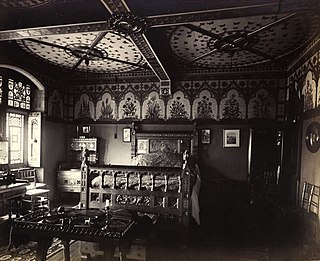
The Golden Bed is a bed designed by the English architect and designer William Burges in 1879 for the guest bedroom of the home that he designed for himself in Holland Park, The Tower House. It is now in the collection of the Victoria & Albert Museum (V&A) in South Kensington. The bed was made by John Walden and carved by Thomas Nicholls. The painting in the central panel of the headboard was executed by Henry Holiday, and the motifs and figures on the bed painted by Fred Weekes. The bed is made from polished hardwood, mahogany and pine.

Charles Harry Ralph Handley-Read was an architectural writer and collector and the first serious 20th-century student of the work of William Burges, "a pioneer in Burges studies who was the first to assess the historical brilliance of Burges as gesamtkunstwerk architect and designer."

Thomas Nicholls was an English sculptor.
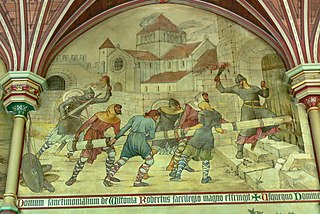
Horatio Walter Lonsdale (1844-1919) was an English painter and designer.

The Church of St Peter, Carrigrohane, is a Gothic Revival church in Cork, Ireland. It belongs to the Church of Ireland and was constructed in 1854, and extended by William Burges in 1865–68. The church is located on Church Hill, Carrigrohane, to the west of Cork city. It stands on the site of an earlier church, and is dedicated to Saint Peter. Along with the Church of the Resurrection and St Senan's Church it is part of the Carrigrohane Union of Parishes in the Diocese of Cork, Cloyne, and Ross.

The Great Bookcase is a large piece of painted furniture designed by the English architect and designer William Burges. The bookcase is 10 feet (3.0 m) high and 5 feet (1.5 m) wide. It has been described as "the most important example of Victorian painted furniture ever made."

The Zodiac settle is a piece of painted furniture designed by the English architect and designer William Burges and made between 1869 and 1871. A wooden settle designed with Zodiac themes, it was made for Burges' rooms at Buckingham Street, and later moved to the drawing room of The Tower House, the home that he designed for himself in Holland Park. Burges desired to fill his home with furniture "covered with paintings, both ornaments and subjects; it not only did its duty as furniture, but spoke and told a story." At one stage the poet John Betjeman gave the settle to the novelist Evelyn Waugh, and it is now in the collection of The Higgins Art Gallery & Museum in Bedford.

The Narcissus washstand is a piece of painted furniture made by the Victorian architect and designer William Burges in 1867. It was originally made for Burges's set of rooms at Buckingham Street and subsequently moved to his bedroom at The Tower House, the house he designed for himself in Holland Park in London. John Betjeman, later Poet Laureate and a leading champion of the art and architecture of the Victorian Gothic Revival, was left the remaining lease on the Tower House, including some of the furniture, by E. R. B. Graham in 1961. He gave the washstand, which he found in a second-hand shop in Lincoln, to the novelist Evelyn Waugh who featured it in his 1957 novel, The Ordeal of Gilbert Pinfold, mirroring a real-life incident when Waugh, in the grip of bromide poisoning, became convinced that an ornamental tap was missing from the washstand.

The Red Bed is a piece of painted furniture designed by the English architect and designer William Burges made between 1865 and 1867. Built of mahogany, painted blood red and decorated with imagery of the Sleeping Beauty fairy tale, it was made for Burges's rooms at Buckingham Street, and later moved to his bedroom at The Tower House, the home he designed for himself in Holland Park. Burges wanted to fill his home with furniture decorated with paintings; they served not only their obvious practical purposes, “but spoke and told a story”. After catching a chill while engaged on works for the Marquess of Bute at Cardiff, Burges returned to the Tower House and died in the Red Bed, aged 53, on 20 April 1881.
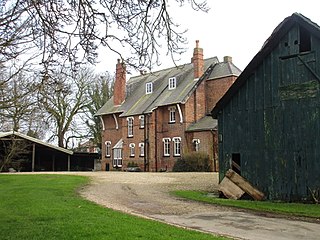
Bewholme Vicarage, in the village of Bewholme, East Riding of Yorkshire, England, is a former vicarage designed by the architect William Burges in 1859. It is a Grade II listed building and is now a private residence.

From 1865 until his death in 1881 the Victorian architect William Burges undertook the reconstruction of Cardiff Castle for his patron, John Crichton-Stuart, 3rd Marquess of Bute. The rebuilding saw the creation of some of the most significant Victorian interiors in Britain.
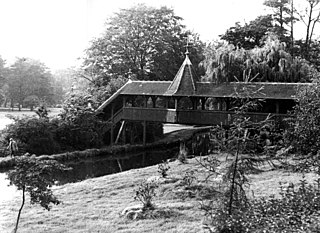
The Swiss Bridge at Cardiff Castle was built by the architect William Burges for John Crichton-Stuart, 3rd Marquess of Bute in 1873. Modelled on the Kapellbrücke in the Swiss city of Lucerne, it provided a link from the castle into Bute's private gardens which now form Bute Park. By the 1960s, the bridge had become dilapidated and it was demolished in 1963.
References
- 1 2 Free Online Library: A Burges Discovery - Free Online Library, accessdate: April 12, 2017
- ↑ Crook 2012, p. 407.
- ↑ "The Frua-Valsecchi collection". The Fitzwilliam Museum.
- 1 2 Crook 2012, p. 292.
- ↑ Crook 2012, p. 294.
- Crook, J. Mordaunt (2012). William Burges and the High Victorian Dream. London: Francis Lincoln. ISBN 978-0-711233-492.
